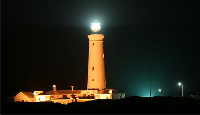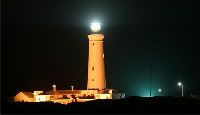By Guest Blogger Julian Phillips: Shining the Light on the Dark Side of Lighting


Let us begin with incandescent bulbs (including halogen):
Incandescent bulbs produce light by heating a metal filament. When electricity passes through the *filament, its temperature rises through resistance, creating a hot glow of approximately 2300 deg C that emits the light. This is also the primary reason why the light is a warm white because most of the energy comes from the heat. This is an outdated technology and is extremely inefficient because it produces 90% heat and 10% light, this has the consequence of releasing more harmful gasses into the atmosphere than required.
C.F.L s (compact fluorescent lights): Compact fluorescent bulbs and tubes are made with glass coated with phosphor and filled with gas and mercury. They produce light when the mercury molecules are excited by electricity running between two electrodes in the base of the bulb. The mercury emits ultra violet light, which in turn excites the tubes phosphor coating, leading it to emit visible light. Each bulb contains between 5-10 milligrams of mercury depending on the size, and 20 milligrams of mercury from one 1200mm fluorescent tube will pollute 7200m cubed of drinking water.
Compact fluorescent tubes and bulbs may be energy saving but they come with a long term environmental disaster that effects every living creature, including ourselves. Mercury in C.F.L s are present as elemental (or metallic) mercury. Once spilled you can be exposed to elemental mercury by touching it, after which it can be eaten and or absorbed through your skin. More importantly for your health you can be exposed to mercury through the air, as elemental mercury vaporizes readily (essentially becomes a gas) and can thus be inhaled into your lungs. Breathing elemental mercury into your lungs is generally more dangerous than if you ate the mercury or absorbed it through your skin.
1) Immediately open windows to reduce mercury concentrations inside your home.
2) Do not touch the spilled mercury.
3) Clean up the broken CFL glass carefully and immediately using disposable gloves and not a vacuum cleaner.
4) Wipe the affected area with a paper towel or use an adhesive tape to remove all glass fragments and mercury and place in a sealed plastic bag.
5) Dispose of the bag at your local household hazardous waste or collection site, which is also how and where all used CFLs should be disposed of.
The lighting industry and energy producers will definitely not want the public to know about this because of their invested interests. For example Eskom have been handing out millions of CFLs for free, but have not made anyone aware of these critical dangers during handling and discarding in the dustbin and not the designated recycling depots. This means that 99% of all those bulbs will end up in landfill through ignorance and short term solutions. Toxic mercury from broken fluorescent tubes and bulbs cannot be decomposed in the environment and will enter river systems during rains destroying fragile ecosystems and ultimately entering the human body through this same ecosystem. To make matters worse, mercury plus carbon dioxide, sulphur dioxide and nitrogen dioxide are all released into the atmosphere for every 1 kilowatt of electricity that is generated by a coal fired power station.
After reading this you might be thinking “Oh! Another doom and gloom environmental splaab”, but fortunately modern lighting technology has advanced enough for each one of us to make a difference and adopt a solution that is not only environmentally friendly but reduces your lighting bill by up to 90%.
L.E.D (light emitting diodes) is modern third generation solid state lighting solutions and are able to replace 90% of common outdated lighting technology. But the sophisticated electrical and physical components including: drivers, aluminum heat sinks and chips make these lights more expensive. So why would you want to pay more for this light?
Due to the lifespan of the L.E.D currently from 30 000 and up to 100 000 depending on the components within the light itself L.E.D s are a very good investment.
Although upfront they are more expensive the money is well spent due to the following reasons.
- They last for 10 times longer so by the time you have bought 10 traditional lights you would have spent more money than just buying one L.E.D
- They consume up to 10 times less energy so during their lifetime they would have saved you up to 80-90% on your lighting bill every month.
- They save you maintenance costs on replacements
- Because of their specialized heat sinks and drivers they run at very low temperatures and are therefore safer and will save you extra expenses on your air conditioning during summer and warm seasons (we all know how much heat a halogen light gives off)
- They can be used in special environments that traditional lights are not suitable for. E.g. Explosion proof, shatter proof, fire proof, waterproof, and toxic environments as well as for any subjects that are sensitive to light and should not be exposed to ultra violate rays.
- They do not give off any harmful rays or gasses and are therefore much better for your eyes, food, artwork, jewelry, or any other objects and substances that are sensitive to light and decay. This coupled with their minimal energy consumption also makes them far more environmentally friendly.
- They come with a 3 year to 5 year warranty that no other lighting can offer
- Best of all they are 110% tax deduct able so you can claim all your money back
- All these factors add up to a far superior product on all levels and a sound investment
Once inhaled, the mercury vapor can damage the central nervous system, kidneys and liver. A potent neurotoxin, children and fetuses and is already an environmental hazard in the oceans with regular contaminations occurring in people who have eaten contaminated fish. These toxic effects are why any mercury spill should be handled carefully. If a breakage or spill does occur, this is what the EPA(environmental protection agency) in the USA advises: Destroying precious oxygen that has taken millions of years to create. So basically in a nutshell it is not an exaggeration by any means to say, that we are poisoning not only ourselves but the rest of the planets life forms while we are at it. Any alarm bells going off yet? Insane is probably the best way anyone from an outside perspective could describe this behaviour. Of course you could also ignore all these tiny details and just carry on but now you can’t say OH! I didn’t know. Look out for the next messy details and solution on the common battery.
By Julian Phillips
Energix Solutions cc
0727279634

As this article states, CFLs do save energy, but they also contain small amounts of mercury. It is important for consumers to realize that CFLs and fluorescent bulbs require special handling and cannot be thrown away in the trash. The mercury vapor can be detrimental to handlers’ health—from those involved with handling new bulbs to people involved with storing, packaging and shipping used lamps. Mercury vapor, which can be absorbed through the skin or inhaled, can cause neurological damage, and when it gets into water, it can enter the food chain through fish. Read more about the dangers of mercury exposure at vaporlok.blogspot.com/2010/05/preventing-health-and-safety-hazards.html.
In the future, if a bulb is broken, it should be properly cleaned up. Also, to reduce the risk for mercury vapor exposure, CFLs and fluorescent lamps should be stored and transported to recycling facilities in a package that is proven to effectively contain hazardous mercury vapor. Find out more about safe packaging and clean-up procedures at vaporlok.blogspot.com/2010/07/cfl-usage-and-what-you-should-do-if-cfl.html